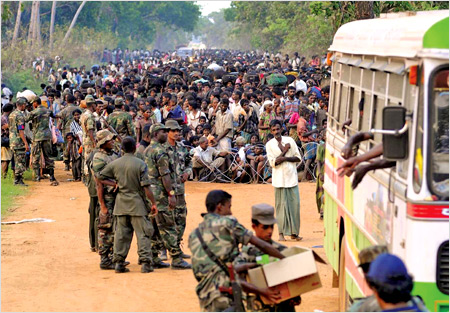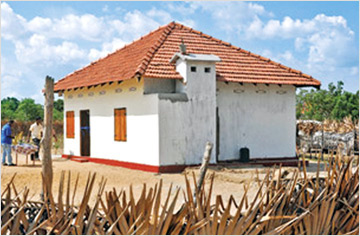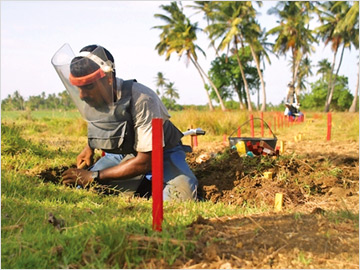|
New condominiums instead of shell-riddled buildings:
'Northern Spring', the mega development plan:
A new era dawns
Identifying priorities,the key factor:
Restoration of health services :
By Dhaneshi Yatawara
 |
|
Resettlement process |
Focusing on
the current development initiative the socio-economic development
realised through the 'Mahinda Chinthana' concept is visible everywhere.
In place of shell and mortar-riddled buildings, new condominiums are
springing up. President Rajapaksa's name is etched in history as the
only leader who gave political leadership to defeat the world's most
ruthless terrorist organisation and unite the country. He has embarked
on an ambitious program to ensure development and reconciliation for a
united nation.
|
The
government handled the operations by initiating priority
policies and strategies to effectively carry out the task and it
was not an ad hoc arrangement. That is why the
government under President Mahinda Rajapaksa, was able to make a
significant achievement in the resettlement of displaced
persons. |
The massive resettlement program inaugurated in the aftermath of the
victory over terrorism drew the attention of the world. That itself
became a yardstick to measure the success of the Government's machinery
launched to support those resettling under the leadership of President
Mahinda Rajapaksa.
The development work was carried out by the Government, even while
the war against terrorism was going on.
The mega development project, 'Uthuru Wasanthaya' ('Northern Spring')
was launched by the Government, operated under the Task Force appointed
by President Rajapaksa was keen to achieve realistic targets on
deadlines.
 |
|
A new house under 'Northern
Spring' program |
The 'Northern Spring' was the mega development program catering to
the needs of all five Northern districts. Infrastructure development,
electricity, water supply and sanitation, agriculture, irrigation,
livestock development, inland fisheries, health, solid waste disposal,
education, sports, cultural affairs and transportation are some of the
areas that will be included under the program.
Priorities
Identifying priorities is the key factor in properly implementing
such a mega project. Without depending on secondary information the
Presidential Task Force, chaired by Minister Basil Rajapaksa, met local
government authorities, villagers, displaced people at welfare centres,
to get a clear picture of the respective localities in order to line up
the priorities.
'Northern Spring' mega development plan focused on three main aspects
security, resettlement and infrastructure development. It was
implemented in three stages 180-days program, short term plan and the
long term plan.
Under the first step, the 180-day program, resettling Internally
Displaced persons started immediately after their homelands were
liberated and demined. Major part of the de-mining activities is
conducted by the Sri Lanka Army and several Non-Governmental
Organisations.
New water supply schemes, restoration of electricity in those areas,
which were key components in developing towns and villages for
resettlement, were successfully carried out under the 'Northern Spring'.
Resettlement was the most complicated process.
Resettlement plan
The resettlement that took place in 2009 was basically to resettle
those who were accommodated in the welfare centre in Manik Farm.
The government handled the operations by initiating priority policies
and strategies to effectively carry out the task and it was not an ad
hoc arrangement. That is why the government under President Mahinda
Rajapaksa, was able to make a significant achievement in the
resettlement of displaced persons.
 |
|
Demining operations |
The Sri Lankan resettlement plan was not merely sending the people
back to their homelands.
The Government provided transport to all those returning to their
villages from the welfare centres. Each family was given a package of
dry food items such as rice, sugar, macaroni, green peas, wheat flour
etc with vegetable oil and vegetables. Separately they were given
another package of clothing items, basic medicinal items, biscuits, milk
powder, tea leaves plates and cups as per the number of members in the
family.
Until they were properly settled down in their villages the line
ministries through the District Secretaries will provide them with their
requirements.
In addition to this, more than 35,000 wells were either reconstructed
or repaired in the Northern Province to give potable water to the people
resettled in their original homesteads.
They were provided with clean toilets and other sanitary facilities
for a clean environment.
Schools in the Northern Province had no roofs. Now, after
rehabilitation and reconstruction almost all the schools are
functioning. The government has spent more than 1.3 billion rupees to
repair the schools.
According to officials the four criteria resettlement was
implemented. The first, resettlement process was voluntary. Second,
displaced persons had to be resettled in their original places of
habitation.
Third, the process should be dignified and safe and the fourth, the
Sri Lanka Army's help was utilised was used for the resettlement.
The restoration of the health services in these five provinces which
were badly damaged during the 30 years of war against terrorism.
Restoring the health care services included renovation of damaged health
institutions, reconstruction of new buildings and procurement of
equipment. The total expenditure for rehabilitation of health care
between 2009-2011 amounts to approximately Rs. 2,135 million and almost
Rs. 9,254 million has been allocated for ongoing projects, most of it
almost getting completed.
Comparing the capital allocation and per capita expenditure in the
health sector during this period with other provinces it shows an
impressive record. The net result is malnutrition in children of-ages
1-2 years has been significantly reduced and the number of dengue cases
reported between 2010 to 2012 reduced compared to other provinces.
Investment
The government has made substantial investment to improve
connectivity. All major highways are being rehabilitated. These include
major roads, provincial roads and rural roads. The total investment is
Rs. 7,500 million.
In agriculture, the Government's action plan is a tremendous success.
It is the most vital economic sector providing basic food security, and
livelihood for 80% of the population. The revival included restoration
of the entire irrigation network, clearing of abandoned paddy lands and
the supply of inputs for agriculture. 90% of abandoned cultivable paddy
lands are now cleared. The extent of land for agriculture increased to
193,200 acres and a production of 212,722 metric tons of paddy has been
recorded.
Under the umbrella of 'Uthuru Wasanthaya', the 180 days program,
major and minor irrigation systems and canals came under repair. Grants
were allocated for repair and reconstruction work of irrigation systems
in all the five districts.
With the revitalisation of farming communities in these provinces,
seed paddy was issued free to farmers as the resettlement progressed. In
addition they were also facilitated with monetary grants to assist them
in preparing their lands for cultivation. Focus was on promoting home
gardening as well as backyard poultry among these communities. And the
usage of organic fertilizer was encouraged too. Depending on individual
requirements, farmers were also provided with push bicycles and water
pumps.
Establishing dairy villages as people slowly resettled was another
boost to the livelihood activities. The private sector also got involved
in this effort.
Milk trade outlets and milk collecting centres were built. A lot of
resources were available in these areas and by effectively getting the
optimum use of these resources the agriculture sector of the province
was revitalized very successfully.
Reminiscing the past, the revival of the North and Eastern Provinces
has been a remarkable process. The path taken to rise from the ashes was
not an easy one for the Government and particularly to its leader.
Amidst all the question marks raised during the processes pointed
towards the leader of the country as the Government had to meet a huge
expense in these development activities. Thus it was not an easy road
for both parties - Government and the people.
Today we can witness the achievements. Few more steps needed to be
taken to provide the demands of the educated youth of these communities
who will complete their secondary and tertiary education.
The rest needed to be done has been done to make the lives of these
people comfortable. In general, life is never going to be easy. There
will be never ending problems. Yet what is important is having a
conducive environment to meet these demands. That we believe is well
established. |

